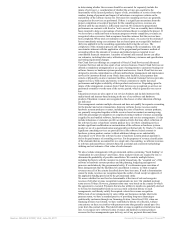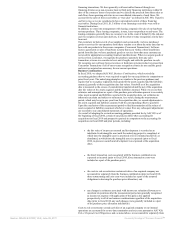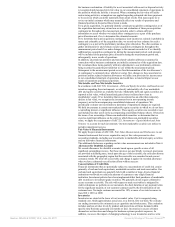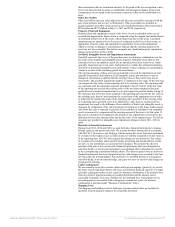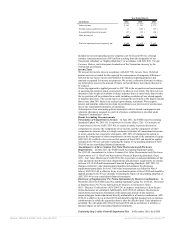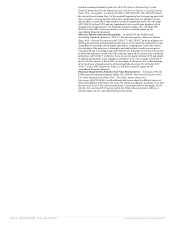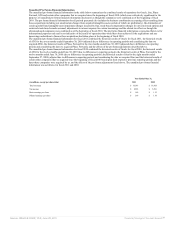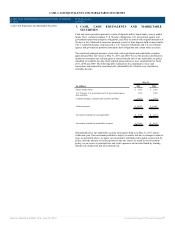Oracle 2010 Annual Report Download - page 172
Download and view the complete annual report
Please find page 172 of the 2010 Oracle annual report below. You can navigate through the pages in the report by either clicking on the pages listed below, or by using the keyword search tool below to find specific information within the annual report.
Foreign Currency
We transact business in various foreign currencies. In general, the functional currency of
a foreign operation is the local country’s currency. Consequently, revenues and expenses
of operations outside the United States are translated into U.S. Dollars using weighted
average exchange rates while assets and liabilities of operations outside the United States
are translated into U.S. Dollars using exchange rates at the balance sheet date. The effects
of foreign currency translation adjustments are included in stockholders’ equity as a
component of accumulated other comprehensive income in the accompanying
consolidated balance sheets. Net foreign exchange transaction gains (losses) included in
non-operating income (expense), net in the accompanying consolidated statements of
operations were $11 million, $(149) million and $(65) million in fiscal 2011, 2010 and
2009, respectively.
Stock-Based Compensation
We account for share-based payments, including grants of employee stock options and
restricted stock-based awards and purchases under employee stock purchase plans, in
accordance with ASC 718, Compensation-Stock Compensation, which requires that
share-based payments (to the extent they are compensatory) be recognized in our
consolidated statements of operations based on their fair values and the estimated number
of shares we ultimately expect will vest. We recognize stock-based compensation
expense on a straight-line basis over the service period of the award, which is generally
four years.
We record deferred tax assets for stock-based compensation plan awards that result in
deductions on our income tax returns based on the amount of stock-based compensation
recognized and the statutory tax rate in the jurisdiction in which we will receive a tax
deduction. We have adopted and apply the alternative transition method as defined within
ASC 718 to calculate the excess tax benefits available for use in offsetting future tax
shortfalls and to determine the excess tax benefits from stock-based compensation that we
reclassify as cash flows from financing activities.
Advertising
All advertising costs are expensed as incurred. Advertising expenses, which are included
within sales and marketing expenses, were $88 million, $75 million and $71 million in
fiscal 2011, 2010 and 2009, respectively.
Research and Development
All research and development costs are expensed as incurred. Costs eligible for
capitalization under ASC 985-20, Software-Costs of Software to be Sold, Leased or
Marketed, were not material to our consolidated financial statements in fiscal 2011, 2010
or 2009.
Acquisition Related and Other Expenses
Acquisition related and other expenses consist of personnel related costs for transitional
and certain other employees, stock-based compensation expenses, integration related
professional services, certain business combination adjustments after the measurement
period or purchase price allocation period has ended, and certain other operating
expenses, net. Stock-based compensation included in acquisition related and other
expenses resulted from unvested options and restricted stock-based awards assumed from
acquisitions whereby vesting was accelerated upon termination of the employees pursuant
to the original terms of those options and restricted stock-based awards. As a result of our
adoption of the FASB’s revised accounting guidance for business combinations as of the
beginning of fiscal 2010, certain acquisition related and other expenses are now recorded
as expenses in our statements of operations that would previously have been included as a
part of the consideration transferred and capitalized as a part of the accounting for our
acquisitions pursuant to previous accounting rules, primarily direct transaction costs such
as professional services fees.
Year Ended May 31,
(in millions) 2011 2010 2009
Transitional and other employee related costs $ 129 $ 66 $ 45
Stock-based compensation 10 15 15
Professional fees and other, net 66 68 35
Business combination adjustments, net 3 5 22
Total acquisition related and other expenses $ 208 $ 154 $ 117
Non-Operating Income (Expense), net
Non-operating income (expense), net consists primarily of interest income, net foreign
currency exchange gains (losses), the noncontrolling interests in the net profits of our
majority-owned subsidiaries (Oracle Financial Services Software Limited and Oracle
Japan), and net other income (losses), including net realized gains and losses related to all
of our investments and net unrealized gains and losses related to the small portion of our
investment portfolio that we classify as trading.
Source: ORACLE CORP, 10-K, June 28, 2011 Powered by Morningstar® Document Research℠








